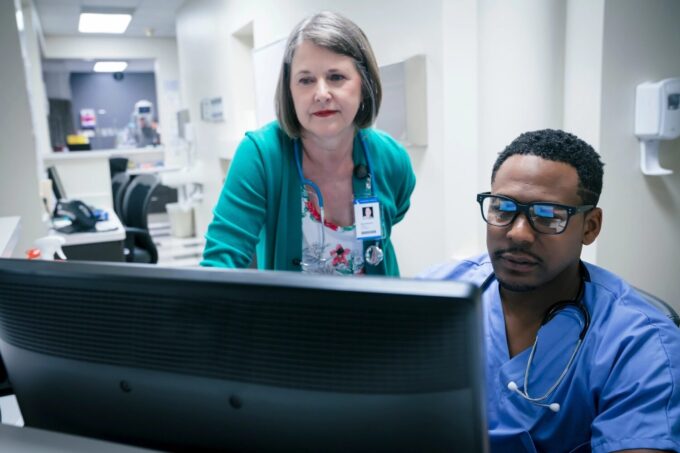Clinical decision support (CDS) tools are quietly reshaping modern medicine. They do not replace doctors;they strengthen them. The concrete impact of these tools lies in how they transform data into action: faster diagnoses, fewer errors, and better treatment alignment with evidence-based medicine.
In real terms, hospitals that use CDS systems report reduced adverse drug events, improved diagnostic accuracy, and higher compliance with clinical guidelines.
These results prove that when technology supports, not substitutes, clinical judgment, patients directly benefit.
What Clinical Decision Support Actually Does

Source: demigos.com
Clinical decision support tools combine patient data, clinical guidelines, and artificial intelligence to give doctors real-time insights at the point of care.
These tools can be embedded within electronic health record (EHR) systems or run as standalone platforms. They alert physicians to potential drug interactions, recommend diagnostic tests, flag abnormal results, and even predict disease progression based on historical data.
For example, if a patient’s lab results and vitals indicate early signs of sepsis, a CDS alert can notify clinicians before symptoms escalate. That early intervention window can save a life.
The same applies to medication dosing: algorithms can catch discrepancies in renal dosing or allergy conflicts that even experienced clinicians might overlook in a busy hospital environment.
At its core, CDS bridges human expertise and machine precision. It captures the complexity of modern medical data and distills it into something usable in seconds, turning information overload into actionable care.
Evidence-Based Medicine, Now Automated
One of the most powerful contributions of CDS systems is their ability to operationalize evidence-based medicine. Physicians often face hundreds of potential treatment paths, each influenced by emerging studies and evolving guidelines.
A CDS system integrates this evidence into clinical workflows, ensuring that recommendations reflect the latest medical knowledge.
For instance, oncology clinics use decision support tools to tailor chemotherapy protocols to genetic profiles. Cardiology units apply risk calculators within EHRs to guide the use of anticoagulants or statins.
These systems don’t just store information; they continuously update and refine it according to new clinical evidence.
The result is a tangible improvement in patient outcomes. Studies from the Journal of the American Medical Informatics Association (JAMIA) show that CDS use leads to a measurable reduction in diagnostic errors and hospital readmissions.
In short, when doctors have better access to current data, patients get safer, more precise care.
Where Artificial Intelligence Comes In

Source: cds.co.uk
Artificial intelligence has taken CDS systems from static checklists to dynamic, predictive tools. Instead of merely reacting to input, modern AI-driven systems learn patterns from massive datasets and anticipate future health risks.
For example, AI models can predict which ICU patients are at the highest risk of sudden deterioration based on subtle trends in their vital signs.
This is where tools developed by healthcare technology platforms like Trust AI become highly relevant. While the platform focuses on dentistry, its model illustrates how AI-driven decision support improves the accuracy of diagnoses and treatment planning.
By analyzing patient images, clinical notes, and procedural data, such systems can help clinicians detect anomalies earlier and choose interventions with higher success rates.
The broader medical field benefits from the same logic: smarter tools create more confident, consistent decisions.
Importantly, AI-based CDS systems also democratize expertise. Smaller hospitals or dental clinics without large research teams can access advanced diagnostic logic instantly, narrowing the gap between community care and academic medicine.
Key Benefits: Measurable and Patient-Focused
The true value of CDS tools is not just in operational efficiency but in measurable patient outcomes. Across disciplines, the following benefits consistently emerge:
| Category | Impact on Patient Outcomes | Example |
| Medication Safety | 30–50% reduction in adverse drug events | Automated drug-allergy and dosing alerts |
| Diagnosis Accuracy | 20–40% fewer diagnostic errors | AI-assisted image interpretation |
| Hospital Readmission Rates | 10–15% lower | Predictive algorithms for discharge planning |
| Clinical Guideline Adherence | 25–35% improvement | Automated evidence-based treatment prompts |
| Patient Satisfaction | Noticeable rise | Faster, clearer communication and tailored care |
Each of these gains represents a real-world change in patient safety, satisfaction, and outcomes, not just administrative efficiency. That’s why hospitals and clinics continue to invest in CDS integration, even amid budget constraints.
Challenges in Implementation
Despite their promise, clinical decision support tools face hurdles. Integration with legacy EHR systems is often messy. Poorly designed interfaces or alert fatigue can frustrate clinicians and reduce adoption rates.
For instance, when systems produce too many alerts, doctors may start ignoring them, even the critical ones.
Data quality is another limiting factor. Incomplete or inconsistent patient records can lead to inaccurate recommendations.
Furthermore, clinicians worry about overreliance: if a system suggests an incorrect treatment path, the human must remain the final filter.
To overcome these issues, healthcare organizations need structured governance, regular audits of CDS performance, and training that emphasizes augmentation, not automation, of clinical reasoning.
The best systems are those that respect the clinician’s judgment and complement it, not compete with it.
How CDS Tools Change Clinical Culture

Adopting CDS technology is not merely a software upgrade; it’s a cultural shift. Hospitals that integrate these tools successfully tend to embrace a data-driven mindset across all departments.
Clinical staff learn to view data as a partner in decision-making rather than an administrative burden.
This cultural change also enables more consistent care delivery. For example, if ten physicians in one hospital treat diabetic patients slightly differently, a CDS system standardizes care based on best practices and updated guidelines.
Patients benefit from predictable, high-quality management no matter who sees them.
Over time, this consistency leads to measurable institutional improvements: lower variability in treatment outcomes, reduced malpractice risk, and a stronger foundation for continuous quality improvement.
The Future: Personalized, Predictive, Preventive
Looking ahead, the next generation of CDS systems will move from reactive prompts to proactive prediction. Instead of alerting physicians after a problem arises, AI-powered tools will identify patients at risk of developing one.
This is especially relevant for chronic disease management and preventive care, predicting heart failure readmissions, diabetic complications, or even mental health crises before they happen.







